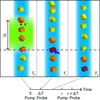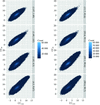issue contents
February 2019 issue
Multi and serial data collection and processing
Proceedings of the CCP4 Study Weekend edited by Charles Ballard, Robin Owen, Max Nanao and Arwen Pearson

introduction
Open  access
access
 access
accessAn introduction to the 2018 CCP4 Study Weekend special issue.
research papers
Open  access
access
 access
accessSynthetic macromolecular crystallography diffraction-image data were generated to demonstrate the challenges of combining data from multiple crystals with indexing ambiguity in the context of heavy radiation damage. The nature of the problems encountered using contemporary data-processing programs is summarized.
Open  access
access
 access
accessCrystallography at multiple temperatures can reveal the collective shifts of alternative conformations that underlie allosteric communication through protein structures.
Open  access
access
 access
accessAn automated data-collection system named ZOO has been developed. This system enabled faster data collection, facilitated advanced data-collection and data-processing techniques, and permitted the collection of higher quality data.
Open  access
access
 access
accessMultiple dose-dependent room-temperature structures of copper nitrite reductase were determined from microcrystals in a single silicon nitride fixed-target chip. The separation of crystal polymorphs into distinct structures is described, together with the characterization of X-ray-irradiation effects through the dose series.
Open  access
access
 access
accessStrategies for sample delivery of macromolecular crystals at X-ray free-electron lasers are reviewed, covering injection methods, fixed-target approaches and hybrid methods.
Open  access
access
 access
accessCurrent developments and challenges for serial sample delivery at synchrotrons and X-ray free-electron lasers are reviewed, including the new megahertz repetition-rate machines, with an emphasis on liquid injection and high-viscosity extrusion.
Download citation


Download citation


Open  access
access
 access
accessA long-wavelength mesh data collection using a size-tailored microbeam from concanavalin A microcrystals with linear dimensions of less than 20 µm allowed experimental phase determination using the anomalous signal from naturally occurring Mn2+ and Ca2+ ions.
PDB reference: concanavalin A, 6h2m
Open  access
access
 access
accessMerging statistics are evaluated in multi-crystal single-wavelength anomalous diffraction phasing and are used to optimize the anomalous signal.
Open  access
access
 access
accessResearch in the area of protein crystallography at X-ray free-electron laser sources is summarized from the perspective of radiation damage, including its mechanisms and effects, ways to minimize it and a comparison with the damage observable at synchrotrons.
Open  access
access
 access
accessA step-by-step guide to processing serial crystallography data from X-ray free-electron lasers and synchrotron sources using CrystFEL is provided.
Open  access
access
 access
accessAn automated method is presented that diagnoses indexing ambiguities and produces a consistent indexing choice for the large majority of diffraction images.


 journal menu
journal menu




























